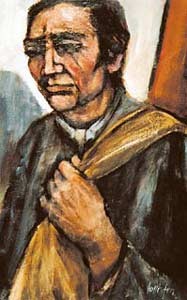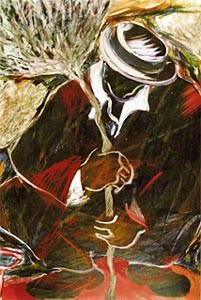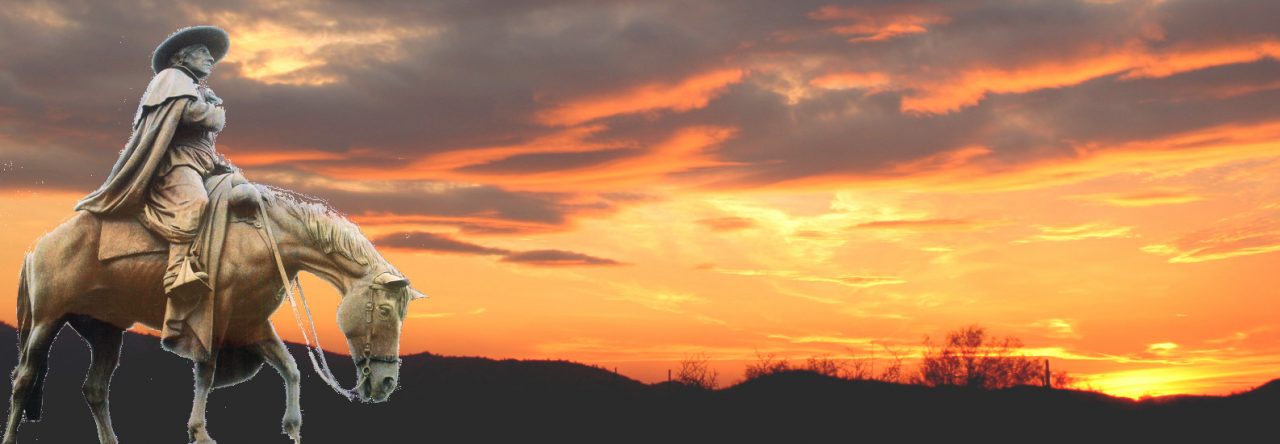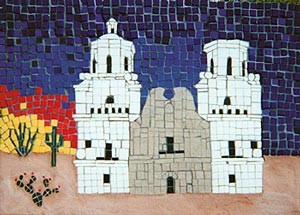Courtesy of the Tucson Citizen ©
January 11th, 2003
MULTICULTURAL EXHIBIT IS HOMAGE TO A MAN WHO MAY BE A SAINT
LORRIE COHEN
Tucson Citizen
, Jan. 11, 2003

Included in the “Homage to Father Kino” exhibit at El Centro Cultural de las Americas are “Omaggio a P. Kino” (left) by Giorgio Tomasi of Italy and “Il Lungo Viaggio” by Annamaria Rossi Zen of Italy. Included in the “Homage to Father Kino” exhibit at El Centro Cultural de las Americas are “Omaggio a P. Kino” (left) by Giorgio Tomasi of Italy and “Il Lungo Viaggio” by Annamaria Rossi Zen of Italy.
 Mark Rossi has given some thought to Father Eusebio Francisco Kino.
Rossi has lived and worked in Tucson for 30 years. But it wasn’t until he was asked to be a part of the “Homage to Father Kino,” an art exhibit and cultural exchange among the United States, Mexico and Italy, that he created a bronze sculpture commemorating Kino.
”I imagined that when Kino died someone was there who cared about him, and maybe someone made a prayer shrine to him on the Sea of Cortez,” says Rossi, describing his work. “So (I created) a prayer memory homage shrine that I imagined someone else did.”
Rossi is one of 33 artists taking part in the event, which starts Sunday and runs through the end of January. It’s hosted by El Centro Cultural del las Americas.
The exhibit will have about 60 art pieces – paintings, engravings, photographs, ceramics, sculptures and mosaics – with a Kino theme.
Mark Rossi has given some thought to Father Eusebio Francisco Kino.
Rossi has lived and worked in Tucson for 30 years. But it wasn’t until he was asked to be a part of the “Homage to Father Kino,” an art exhibit and cultural exchange among the United States, Mexico and Italy, that he created a bronze sculpture commemorating Kino.
”I imagined that when Kino died someone was there who cared about him, and maybe someone made a prayer shrine to him on the Sea of Cortez,” says Rossi, describing his work. “So (I created) a prayer memory homage shrine that I imagined someone else did.”
Rossi is one of 33 artists taking part in the event, which starts Sunday and runs through the end of January. It’s hosted by El Centro Cultural del las Americas.
The exhibit will have about 60 art pieces – paintings, engravings, photographs, ceramics, sculptures and mosaics – with a Kino theme.
of the American artists are from the Tucson area.
The idea for the project began in April 2001 after a group of artists got together in Caborca, Mexico. The exhibit started in Segno, Italy, where Kino was born and a museum has been built in his honor. The exhibit is making its way to Sonora, Mexico, and will end up in Magdalena, where Kino died almost 300 years ago. The Tucson stop is the only one in the United States.
Claudio Chini of Segno, a Kino descendant from Italy, will be at an opening reception Saturday.
”They (group of artists) liked the idea when we met, and we were thinking about something with Father
because we have a lot in common,” says Blanca Villalobos, exhibit coordinator and curator, who will also have two Kino-themed oil paintings on display. “I’m happy, and the artists are happy. It was a lot of work, and everyone coming together is exciting.”
It’s also an exciting time for local artist Ramon Arturo Trevizo.
Although the 33-year-old has been perfecting his craft for eight years, this is his first exhibit. He has two pieces in the show, one a mosaic of San Xavier Mission.
”I chose it because if you live in Tucson, it’s Father Kino’s tie with Tucson,” says Trevizo, who didn’t end up going to Italy, but his mosaic did.
It’s also a first for host El Centro Cultural de las Americas.
”We’ve had receptions and weddings and small concerts and readings and art showings by in-house artists, but not an (international) exhibit,” says John Huerta, El Centro’s board adviser. “We jumped at the opportunity. This is the oldest inhabited building in the city, next to the mission, so it’s very appropriate that it’s housed here. So we raised the money, and here we are.”
El Centro Cultural de las Americas, a Hispanic cultural center, maintains the property, called the Charles O. Brown House, at 40 W. Broadway. It was originally a pioneer Tucson house and now is a historic landmark. The property is owned by the state and the Arizona Historical Society.
The exhibit will also have a group of
Kino artifacts on loan from the University of Arizona Library and the Arizona State Museum. Huerta says the timing of this event is also important. ”Father Kino is in the process of going through a canonization eventually leading to becoming a saint,” he says. “So we knew that this would also be an educational experience for the people here. Kino is a beloved figure to begin with. He’s very unique in our history.”
IF YOU GO
What: “Homage to Father Kino,” an art exhibit and cultural exchange featuring 33 artists from Italy, Mexico and the United States.
Where: El Centro Cultural de las Americas, 40 W. Broadway.
When: 10 a.m. to 4 p.m. Tuesdays through Saturdays and noon to 4 p.m. Sundays, Jan. 12-31.
Details: It’s free. For more information, call 621-1481.
FATHER KINO
Father Kino was born in the Italian Tyrol (today’s northern Italy) in 1645 in a town called Segno. His family name was originally Chini. He was first educated in Jesuit colleges, but at age 18 he suffered a serious illness. He promised his patron saint, St. Francis Xavier, that he would become a missionary if he recovered. He continued to train to be a Jesuit until 1677. It was his enthusiastic Jesuit missionary career that took him from Europe to the New World.
Within one year of his arrival, he was appointed missionary and cosmographer for the California Expedition that included Baja California. He introduced Christianity and the Spanish Empire to what is now a wide area of southern Arizona and northern Sonora, Mexico. He also introduced wheat and beef cattle to the region. More than three centuries after Kino’s arrival, the regional Mexican and native diet is still strongly based on beef, cheese and wheat products.
A rancher and cattleman, Kino taught the Pimas to diversify and expand their agriculture. Indians in his various missions numbered 30,000, and he personally baptized 4,000 converts.
Kino labored in the Pimería Alta until March 1711, when he arrived in Magdalena to dedicate a new chapel to St. Francis. He fell suddenly ill and died near midnight on March 15, 1711. He was buried beneath the floor of the chapel he had come to dedicate. His bones were rediscovered in 1966, long after the chapel had disappeared. They are on display in their final resting place in the Magdalena plaza.
Perhaps Kino is best known for choosing the site of San Xavier Mission in 1700. It was named for his patron saint. Work on the present structure started about 1783 and was completed in 1997.
There’s also a statue of Kino on horseback along South Kino Parkway.
Sources: Tucson Citizen archives, University of Arizona
Copyright © 2003 Tucson Citizen


 Italiano
Italiano Español
Español Deutsch
Deutsch

